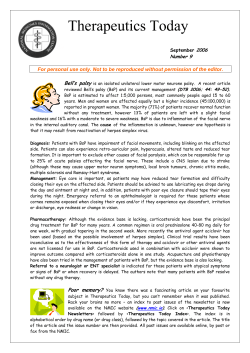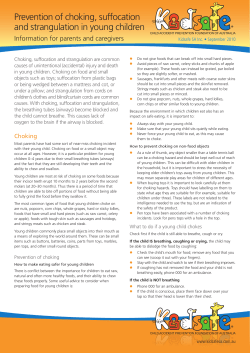
Emergency Department fact sheets Croup in children
Emergency Department fact sheets Croup in children health • care • people www.health.qld.gov.au/emergency What is croup? Home care Croup (medically called laryngotracheitis) is a viral infection of the throat, which affects the voice box (larynx) and windpipe (trachea). • Stay calm. Try to keep your child calm also. Croup can be very frightening for a child, but being scared makes it worse. Try watching television or reading a book with your child to help them relax. Croup is common in babies and young children during winter. Most cases are mild. These include cases where a child has a ‘barking’ cough, but no trouble breathing. Children are best cared for at home. • Offer your child plenty to drink. Offer small amounts (‘sips’) and often, especially if your child has a fever. Water is best. Sometimes croup can become more serious with the child having difficulty beathing. • Sit your child up in bed with pillows to make breathing easier. What causes croup? • Offer paracetamol (such as Panadol or Dymadon) if your child has a fever and is miserable. Carefully check the label for the correct dose and make sure you are not giving your child any other products containing paracetamol (such as some cough medicines and cold and flu peparations). Children have small, soft windpipes. A viral infection causes the lining of the windpipe and voice box to swell. This, along with a build-up of sticky fluid mucous), narrows the passageway through which air travels into the lungs. This can make it difficult for your child to breathe. As children get older, the size and strength of the windpipe improves, which is why croup is less common in older children. What are the symptoms of croup? Croup usually starts as a common cold (with a runny nose, red eyes, sore throat and a fever). Then the following symptoms develop: • a hoarse voice • a harsh, ‘barking’ cough (like a seal’s bark) • noisy breathing (a high pitched noise when breathing in, known as stridor) • fast or laboured (hard) breathing. These symptoms often start at night when the air is cold and dry. They can get worse when your child is upset. Treatment • In the emergency service, your child may receive a medicine called prednisolone or dexamethasone. This helps reduce the swelling in the airways, making it easier for your child to breathe. It will work in four to six hours. • If the croup is severe, another medicine, called adrenaline, may be given through a nebuliser (which lets you breathe in the medication) or an injection. This relieves the spasm and swelling until the prednisolone starts to work. • Antibiotics will not help, as croup is caused by a virus. • There is no proof that anti-allergy medication (antihistamines) or cold remedies (decongestants) are of benefit with croup. • Steam therapy does not help. It is also regarded as dangerous because of accidental burns, so is not advised. What to expect • Croup may last one or two days and only occur at night. Sometimes it can last up to a week, and may be present during the day as well (it is usually worse at night). The firs two days are usually the worst. • Croup is often a mild illness but can get worse quickly. Do not hesitate to seek medical help if this is the case. A child with severe croup will need prompt treatment in hospital. • Some children can get croup more than once. It is not possible to prevent croup. Seeking help In a medical emergency go to the nearest hospital emergency service or call an ambulance (dial 000). For other medical problems see your local Doctor or health-care professional. 13 HEALTH (13 43 25 84) provides health information, referral and teletriage services to the public in all parts of Queensland and is available 24 hours a day, 7 days a week, 365 days a year for the cost of a local call*. *Calls from mobile phones may be charged at a higher rate. Please check with your telephone service provider Want to know more? Ask your local doctor or health care professional. • Visit the Royal Children’s Hospital website www.rch.org.au/kidsinfo • Visit Healthinsite www.healthinsite.gov.au • Visit the Better Health Channel www.betterhealth.vic.gov.au • Notes: Follow up: Date and time- Name- Disclaimer: This health information is for general education purposes only. Please consult with your doctor or other health professional to make sure this information is right for you. The design and general content of this factsheet are reproduced with the permission of the Victorian Minister for Health, from factsheets that are Copyright © the State of Victoria. Unauthorised reproduction and other uses comprised in the copyright are prohibited without permission. Croup in children
© Copyright 2025





















